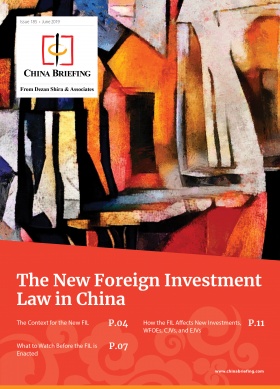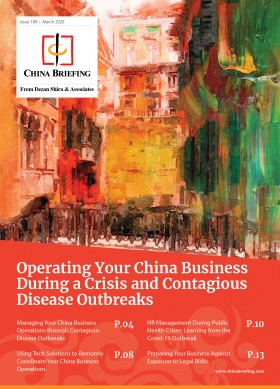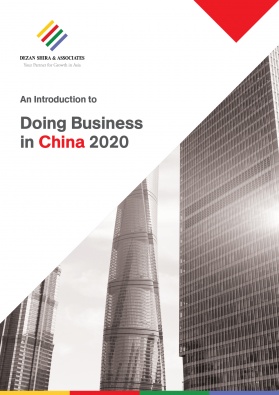What is the China Standards 2035 Plan and How Will it Impact Emerging Industries?
China is set to release an ambitious plan to write global standards for the next generation of technology, a move that could have enormous implications for tech industries worldwide.
The China Standards 2035 plan will lay out a blueprint for China’s government and leading technology companies to set global standards for emerging technologies like 5G internet, the Internet of Things (IoT), and artificial intelligence, among other areas. It will work in concert with China’s other industrial policies – namely the controversial Made in China 2025 policy – as the country’s leaders seek to become global leaders in high-tech innovation.
The plan is the culmination of a two-year research project that began at the start of 2018, led by the General Administration of Quality Supervision, Inspection and Quarantine (AQSIQ) and carried out by the Chinese Academy of Engineering.
While the full report has not yet been released to the public, it is clear that it puts forward ambitious plans for China to reshape the global technology industry. Due to its importance to China’s top leadership, foreign investors should acquaint themselves with China Standards 2035, whether or not they directly operate within the tech industry.
What are industry standards?
Simply put, the tech industry, along with other industries worldwide, use standardized processes and specifications to ensure that products are built to work together seamlessly. If each country or company set its own standards, technologies would not be able to easily work with products designed by other companies or work in other markets. In effect, standards allow products to be designed and produced at scale and used worldwide.
A basic example of standards is light bulbs. Light bulbs are made in standard sizes and strengths, which make it easier for consumers to use and, crucially, allows them to fit into the sockets of light fixtures made by different companies. A more current example of a standard is the near universal use of Wi-Fi for wireless networking.
Standards can also be proprietary and for profit. For example, Google’s Android operating system is open-source in order to promote standardization among smartphone makers and app developers, but companies still must pay licensing fees to use it.
There is not a single process by which standards are created. Generally speaking, they are set by a combination of private companies who are industry leaders as well as by international industry associations. Standards are enforced either as a convention – a “best practice” – or as formal agreements, depending on the industry and product.
Standards are not just useful for solving practical issues of compatibility, but also because they accelerate innovation. When companies use open standards rather than proprietary ones, they do not need to devote resources to developing their own internal systems and can instead follow established practices.
Is the China Standards 2035 Plan linked to the ‘Made in China 2025 Plan’?
Chinese policymakers often invoke the idea that third-tier companies make products, second-tier companies design technology, and first-tier companies set standards.
According to this line of thinking, China is currently home to mostly third-tier companies – those that produce designs originally created abroad. Made in China 2025, a key industrial policy for the development of tech in China, seeks to foster second-tier companies that are leaders in design and innovation.
As such, the China Standards 2035 project endorses and builds upon Made in China 2025. In effect, the goal of the latter – to transform China into a leading tech innovator and producer – is a stepping-stone in achieving the former.
In many ways, then, Made in China 2025 and China Standards 2035 are two parts of the same wider strategy. Before setting global standards, China must become self-sufficient in designing and producing high-tech products like semiconductors, for which the country still largely relies on foreign companies.
Made in China 2025 raised alarm bells for many foreign companies and governments, who viewed it as a blueprint for the Chinese government to nurture domestic champions by giving them preferential treatment and pushing out foreign competitors. Nevertheless, although Made in China 2025 drew ire overseas, and was subsequently buried by policymakers, the China Standards 2035 plan shows that the government is not backing off.
To transform China into an incubator of first-tier companies that set the rules of the game, China Standards 2035 stresses the importance of becoming a leader in the next generation of emerging technologies.
Due to China’s stage of development at the time of the internet boom, government leaders generally consider that China missed out on the opportunity to shape standards for products like smartphones and software. As such, policymakers emphasize the importance of China dominating fields that they see will drive the next industrial revolution, such as in automation and green technology. This will take the shape of government support for these industries, such as through investments in “new infrastructure” that are likely to be part of China’s post-COVID-19 economic stimulus.
Further, before setting global standards, the China Standards 2035 plan will likely emphasize the importance of making sure standards are set domestically, as in practice there is wide variation in how policies are interpreted and implemented at the local level. The central government, then, will prioritize coordinating standards across the country before turning its sights globally.
Eventually, however, setting standards will require China to push its companies and preferences internationally. This includes by increasing Chinese participation in multilateral bodies, such as the World Trade Organization, where the government already has a significant presence.
Another part of going abroad is exercising economic influence and selling lower cost products to gain market share. As such, the Belt and Road Initiative – an ambitious plan to build infrastructure and trade corridors across Eurasia and elsewhere – will be instrumental in spreading Chinese standards.
What are the business implications?
A major benefit of leading standards is being able to influence them in a way that benefits one’s own strengths and ambitions. In this way, if China were to lead standard setting, they may be used to privilege domestic companies, such as the telecommunications giant Huawei.
Besides influencing the direction of standards, however, is the more basic issue of licensing fees. Because most proprietary standards in the tech industry are created by foreign companies, China is the world’s second largest payer of licensing fees in the world. China Standards 2035, then, seeks to reverse this relationship and make China a net recipient of licensing fees.
That is not to say, however, that China Standards 2035 will necessarily shut out foreign companies completely. As long as foreign companies remain industry leaders in tech, their voices and input will still be influential in setting standards and will be in demand by Chinese companies.
In the near-term, China’s push to lead standards will add more fuel to already existing trade tensions, particularly in regards to tech, as discussed in a timely report by the Hinrich Foundation on Strategic US-China Decoupling in the Tech Sector. The US, for example, issued rules in May that would require chipmakers using US technology to acquire a license to be able to sell to Huawei. However, on June 30, it was reported that the US Federal Communications Commission (FCC) had “formally designated Huawei Technologies Co and ZTE Corp as posing threats to US national security”. Decisions such as these are likely to become more common as technology tensions between China and the US increase.
If the global tech industry continues to become more politicized, it is possible that global standards gradually bifurcate in kind. As such, in sensitive tech areas that relate to personal data and national security, global standards may become split into those complying with Chinese standards and those applied elsewhere.
The precise business implications, however, will only be clear once the China Standards 2035 plan is released in its entirety, later this year. Foreign investors should therefore be prepared not just for the long-term economic consequences of the policy, but also the associated political risks.
Editor’s Note: This article was originally published on May 20, 2020. It has been updated to reflect new developments.
About Us
China Briefing is written and produced by Dezan Shira & Associates. The practice assists foreign investors into China and has done so since 1992 through offices in Beijing, Tianjin, Dalian, Qingdao, Shanghai, Hangzhou, Ningbo, Suzhou, Guangzhou, Dongguan, Zhongshan, Shenzhen, and Hong Kong. Please contact the firm for assistance in China at china@dezshira.com.
We also maintain offices assisting foreign investors in Vietnam, Indonesia, Singapore, The Philippines, Malaysia, Thailand, United States, and Italy, in addition to our practices in India and Russia and our trade research facilities along the Belt & Road Initiative.
- Previous Article China’s 2020 New Negative Lists Signal Further Opening-Up
- Next Article China’s Support Policies for Businesses Under COVID-19: A Comprehensive List









